PinotFile: 10.13 June 27, 2015
|
Exploring the Heritage Vineyards of Sonoma County: A Trip Well TakenEach year I donate a “Russian River Valley Immersion” guided tour to ¡Salud! Oregon Wine Auction. This auction is a collaboration between Oregon wineries and healthcare professionals from Tuality Healthcare intended to provide access to health care for Oregon’s vineyard and winery workers and their families. ¡Salud! is named for the traditional Spanish toast, “To your health.” As I am a retired physician, this charity is one I wholeheartedly support. The charity’s major fundraiser is the two-day ¡Salud! Oregon Wine Auction held each year in early November. The Russian River Valley Immersion Trip auction item that I sponsor is three days of private, focused winery and vineyard tours and tastings, gourmet meals and lodging. The group included (left to right in the photo below taken at Cohn Vineyard), myself and my spouse Patti, our wino friends Roxanne and Andy Talley, the 2014 auction winners Donna Parkinson and Michael Burkhart and their inviting guests, vintner Harry Peterson- Nedry (Chehalem Vineyards) and Didi Nowers. The troopers found plenty of joie de vivre over three days in Sonoma County, largely due to the generosity of the wineries and growers who I called upon to host our group.
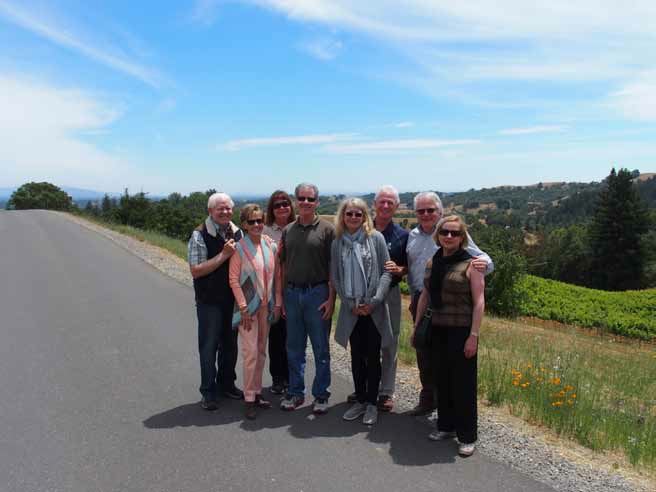 This year’s Russian River Valley Immersion Trip focused on heritage Pinot Noir vineyards in Sonoma County planted before 1980. Hyde Vineyard was included although it is in Napa County (Napa Carneros). Thanks to winemaker and partner of Benovia Winery, Michael Sullivan, the Bacigalupi family, Tom and Joe Rochioli of Rochioli Vineyards, winemaker Shane Finley of Lynmar Estate, winemaker Eva Dehlinger of Dehlinger Winery, the Pellegrini family of Olivet Lane Estate, the entire staff of Hanzell Winery, winemaker James Hall of Patz & Hall, and winegrower Larry Hyde of Hyde Vineyard. All these notable wineries and winegrowers are highly successful, and sell out of their wines annually to eager wine enthusiasts, but they generously gave of their time and resources to support ¡Salud! The charity does not benefit them directly, but the wineries participate as a goodwill nod to others in the wine industry as well as supporting the charity’s goals. The 2015 ¡Salud! Oregon Wine Auction will be held November 13-14. 45 of Oregon’s most sought after wineries will debut the 2014 vintage and uncork their ¡Salud! Cuvées - collectible Pinot Noirs crafted exclusively for ¡Salud! The Cuvée Tasting and Big Board Auction will be held Friday, November 13, at Ponzi Vineyards, and the Dinner and Auction Gala will be on Saturday, November 14, at The Allison Inn & Spa. For event information and to purchase tickets, visit www.saludauction.org. Most all the wines served during the 3-days were from heritage vineyards in Sonoma County culled from my personal cellar. I will mention them in the pages to follow. There are several heritage Sonoma County Pinot Noir vineyards that I was not able to include in this trip. They include Van de Kamp Vineyard (first planted in the late 1950s or early 1960s), Joseph Swan Trenton Estate (first planted in 1969), Bohan Vineyard (first planted in 1973), and Arrendell Vineyard (first planted in 1975). I am sure I am missing a few others. There are precious few old vine Pinot Noir vineyards in Sonoma County that are still productive. Age is a valuable commodity in vineyards. Ted Lemon, of Littorai, noted recently in The World of Fine Wine (Issue 48, 2015), “Vine age is the key to balance. There’s no substitute for vine age.” The aged vine has more potential for reflecting the essence of a vineyard, or at least reflecting a unique character of the site. I don’t believe you can truly appreciate a wine if you haven’t visited the vineyard it came from. You have to walk the rows, kick some dirt, spit some seeds, take in the ambiance and smells, and rub shoulders with the vineyard manager and/or winemaker. When you have the opportunity to visit an aged vineyard with its many gnarled, thick vines, the impression can be even more beholding. On your next trip to Sonoma County, I urge you to arrange a visit to one of the heritage vineyards featured in this issue.
Cohn VineyardThis vineyard (not to be confused with the Cohn Vineyard at BR Cohn Winery in Glen Ellen) was originally planted by Enid Sales, an architectural historian, preservationist and contractor renowned for restoring Victorian homes in San Francisco, and her partner in 1970. They chose the unlikely pairing of Pinot Noir and Zinfandel since that is what they liked to drink. 6.19 acres were planted on a rocky hillside to a massale selection of Pinot Noir, likely Martini and Pommard on St. George rootstock with 11’ x 9’ spacing, and 3.66 acres of Zinfandel. The second owners of the vineyard were Arne and Tekla Cohn of Berkeley, California, who acquired the property in the early 1980s, lent the vineyard its name, and planted an additional 5.11 acres of Zinfandel in 1986. They established the vineyard’s reputation for producing exceptional fruit. Joe Anderson and Mary Dewane, proprietors of Benovia Winery, acquired the Cohn Vineyard in 2002 and planted an additional 2.64 acres of Pinot Noir in 2009. Today, Benovia Winery farms about 9 acres of Pinot Noir and 8.7 acres of Zinfandel. The vineyard is part of a 55-acre ranch on a beautiful site at 700 feet elevation, framed by redwood forests, with expansive views of the Russian River Valley below. Located in the far northwestern corner of the Russian River Valley and technically not in the Russian River Valley AVA, the vineyard has always been dry farmed and was difficult to establish because of the lack of water. The vines struggle to produce in a low vigor, iron-rich soil of clay loam, known as ‘Terra Rosa” for its intense red color, mixed with cobblestones and quartz (see photo below). Yields average a meager 1.0 to 1.5 tons per acre.
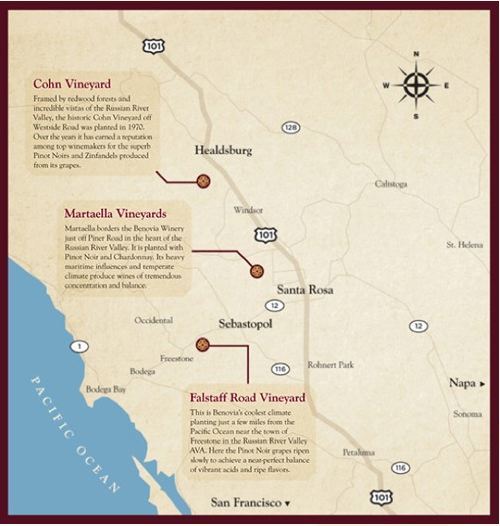
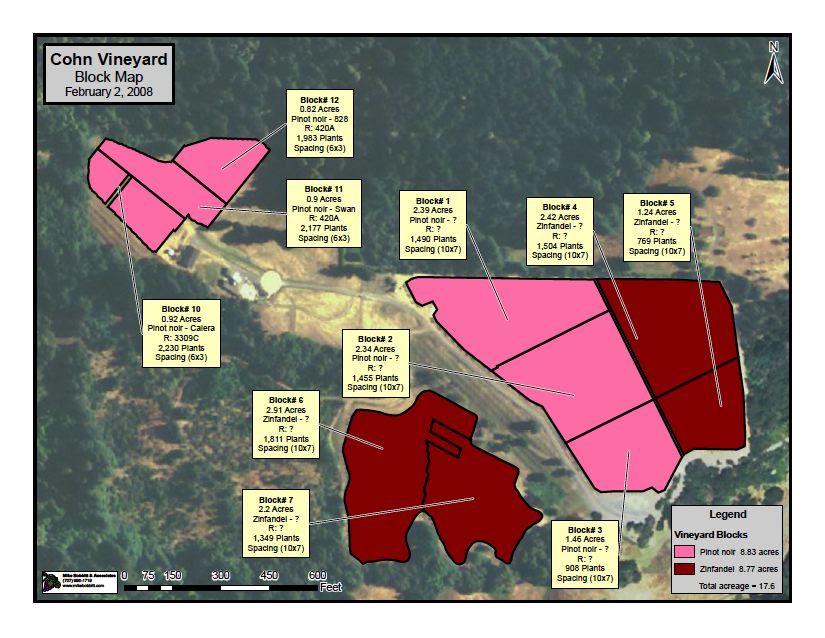
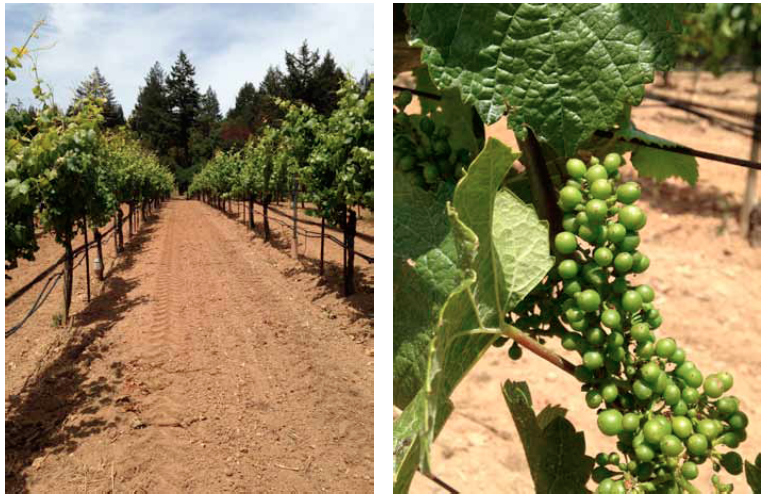 For about five years, the Cohns sold grapes to Hop Kiln Winery. The first Cohn Vineyard Pinot Noir bottling that Benovia Winery winemaker Michael Sullivan is aware of was the 1981 Hop Kiln Winery Russian River Valley Pinot Noir, but it was not vineyard designated. Subsequently, winemaker Burt Williams, who was friends with the winemaker at Hop Kiln Winery, became aware of Cohn Vineyard. Burt waited until the contract with Hop Kiln Winery expired, and began to source grapes from Cohn Vineyard beginning in 1987. The vineyard’s grapes were usually blended into the Russian River Valley and Sonoma County bottlings at Williams Selyem, but a vineyard-designated Cohn Vineyard Pinot Noir was produced in 1988 and 1993. Burt dropped the vineyard in 1995 when owner Arne Cohn put in drip irrigation and over watered the vineyard.
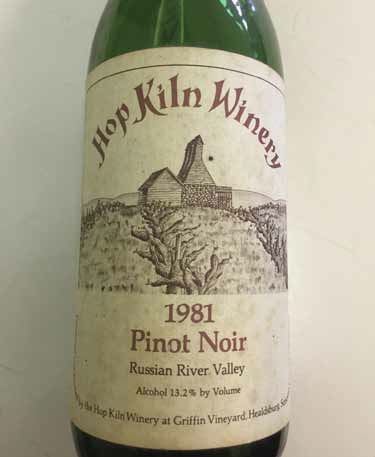 Mary Brogan, Burt Williams’ daughter, sourced grapes from Cohn Vineyard in 2004, 2005 and 2006, vineyard designating the 2004 wine and blending it into her Russian River Valley blend the other two vintages. A little-known bit of trivia is that Kosta Browne made its first commercial Pinot Noir from Cohn Vineyard in 2000. While working at Deerfield Ranch Winery in Sonoma Valley, Michael Browne, working with winemaker Robert Rex, was also involved in the production of a Deerfield Ranch Winery Cohn Vineyard Pinot Noir from 2000 to 2002. The Cohn Vineyard grapes were sourced through John Ferrington who worked with Williams Selyem until 1997. He also made some Cohn Vineyard Pinot Noir in 2000, but tragically committed suicide in 2001. With the blessings of John’s parents, Michael Browne and Dan Kosta split the grapes from Cohn Vineyard with Deerfield Ranch Winery in the 2002 vintage. Kosta Browne also made a vineyard-designated Cohn Vineyard Pinot Noir in 2003, 2004, 2005, 2012, and 2013. In 2006, the Cohn Vineyard grapes were included in the Kosta Browne Russian River Valley appellation blend. The vineyard was extensively rehabilitated after acquisition and organically farmed since 2009 under the direction of Benovia Winery’s winemaker Michael Sullivan (photo below) Thursday afternoon Michael Sullivan took us on a tour of Cohn Vineyard where the vistas are breathtaking.
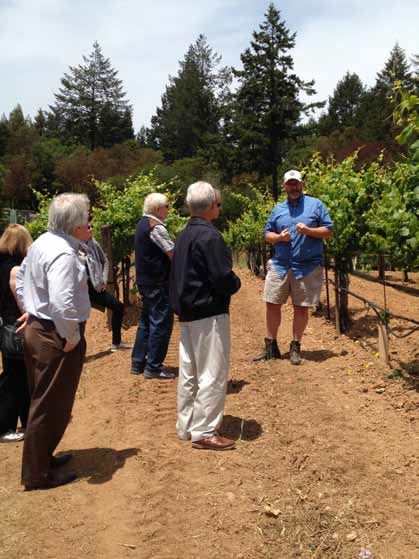 Michael Sullivan hosted the group for lunch at Bistro Ralph in Healdsburg, a superb French bistro that is a hangout for many winemakers. Lunch wines:
2012 Benovia La Pommeraie Russian River Valley Chardonnay 14.5% alc., 350 cases, $48. Sourced from George Martinelli Vineyard (Zio Tony) located at the edge of the Green Valley AVA. The vineyard is planted at a very high density of 2420 vines per acre to Dijon clones 548 and 95. The site was once an apple orchard, so Benovia pays homage to the Martinelli family and the history of the site by naming the wine ‘La Poommeraie’ - French for apple orchard. Indigenous yeast fermentation, 100% malolactic fermentation, and aged sur lie for 16 months in 40% new French oak barrel. · Light golden straw color in the glass. The perfume of pear, caramel and toffee leads to a rich, full, smooth palate of lemon curd, pear and spice flavors. A luscious Russian River Valley style Chardonnay that offers plenty of pleasure. Score: 91
2009 Benovia Cohn Vineyard Sonoma County Pinot Noir 14.1% alc., $62. Previously reviewed very favorably July 23, 2011, and January 11, 2012. · The wine is aging nicely, offering mid weight, sappy flavors of earthy dark plum and dark berry fruit with exotic spices, melded tannins, and a persistent finish. Score: 90
2013 Benovia Cohn Vineyard Sonoma County Pinot Noir 14.1% alc., unreleased. · Moderately light cherry red color in the glass. Lovely perfume of cherries, cake spice, sandalwood and smoky oak. Modestly light in weight in this vintage with a core of red cherry fruit accented with cola, spice, and oak seasoning. Soft and silky on the palate, with modest tannins and some finishing length. When tasted the following day from a previously opened and re-corked bottle, the nose had really come alive with vibrant cherry and spice aromas. There is noticeable smoky oak on the finish which may or may not appeal depending on your preferences. Score: 90-91
2013 Benovia Tilton Hill Vineyard Sonoma Coast Pinot Noir 14.2% alc., unreleased. · Moderately light garnet color in the glass. Darker red and purple fruits are featured on the nose and palate, with hints of sage and other dried herbs, spice, and noticeable oak overlay. Modest in weight in this vintage, with suave tannins and some intensity on the mineral-laden finish. Again, your enjoyment of this wine will be predicated on your preference for oak infusion. Score: 90-91
Note: There is a striking difference in the extraction of the 2013 Cohn and Tilton Hill Pinot Noirs compared to the bombastic 2012 wines. The 2013 wines are less structured and sappy, but have more finesse, interesting savory notes, redder fruits, and more oak overlay. The wines are still very young, and I look forward to tasting them again in 6 months or so.
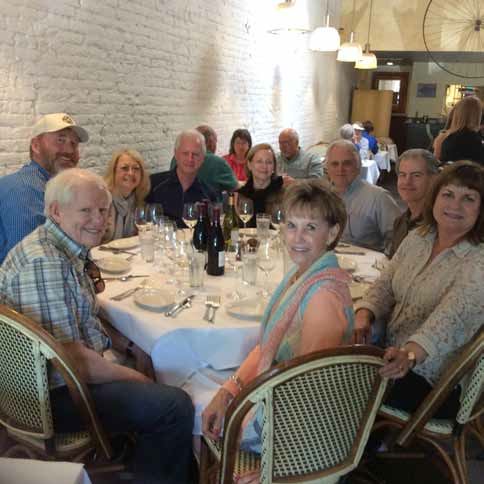
Bacigalupi Paris Tasting BlockThe 1976 Judgment of Paris tasting forever changed the way the world viewed California wines. At this legendary blind tasting, a panel of nine French judges overwhelmingly selected a California Chardonnay wine over their own. The Bacigalupi family continues to farm one of the original vineyards that comprised the 1973 Chateau Montelena Chardonnay that won this esteemed tasting. Charles Bacigalupi was a successful dentist in Healdsburg who first heard about Chardonnay during the 1960s. He had acquired the 121-acre Goddard Ranch on a bench on Westside Road in 1956. Bob Sisson, the University of California farm adviser for Sonoma County at the time advised Russian River Valley growers including Charles to plant Chardonnay. Charles obtained budwood for his Chardonnay plantings from Karl Wente’s Livermore plantings and planted 6 acres on St. George rootstock just off Westside Road at Goddard Ranch in 1964.
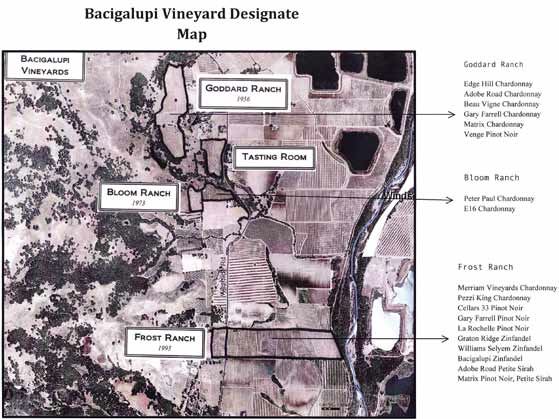 In 1973, the Bacigalupis sold their Chardonnay to Chateau Montelena, a winery in Napa Valley. Winemaker Miljenko “Mike” Grgich made 1,800 cases of the 1973 Chardonnay, crafted from 40 tons of Chardonnay grapes from growers in the Russian River Valley, Alexander Valley and Napa Valley. 14 of the tons were from the Bacigalupi vineyard in the Russian River Valley, about 20 tons from grower Henry Dick in Alexander Valley, and the remaining 5 tons from Napa Valley growers John Hanna and Lee Paschich. The wine was fermented slowly and spent 6 months in French oak barrels before bottling. The wine label attributed the grape source to “Napa and Alexander Valley,” in an attempt to downgrade the contribution of Napa’s rival, Sonoma County. The original weight tag from 1973 that is currently displayed in the Bacigalupi’s tasting room:
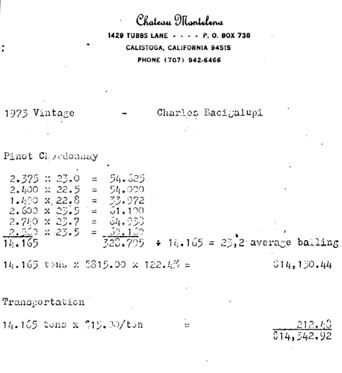 The 1973 Chateau Montelena Chardonnay that Grgich crafted was included in a 2014 Smithsonian exhibition “101 Objects That Made America,” along side Abraham Lincoln’s hat, Alexander Graham Bell’s Telephone, and Neil Armstrong’s space suit.
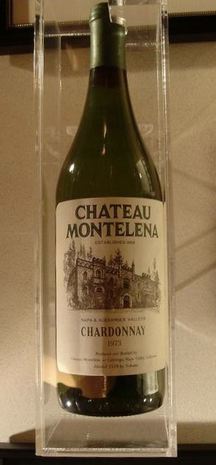 The 3-acre historical Paris Tasting Block of Chardonnay on the Bacigalupi ranch still exists untouched today. The family has vowed to keep the vineyard the same until it has pushed out its last grape. Currently, the fruit is sold exclusively to Rudd Winery in Oakville, where it is bottled under the Edge Hill label. Established in 1867, Edge Hill was the first significant gravity-fed winery built in Napa Valley, and by 1880, was one of the four wineries responsible for over half of Napa Valley’s wine production. In 1999, this legacy inspired Edge Hill’s new steward, Leslie Rudd, to begin the historic restoration of the estate. Wines bottled under the Edge Hill label pay homage to California’s historic vineyards and the rich history of California viticulture. In my opinion, the Edge Hill Chardonnay is one of the top Chardonnays produced in California. Our group drank the 2012 Edge Hill Bacigalupi Vineyard Russian River Valley Chardonnay in the vineyard with the current caretakers, John and Pam Bacigalupi. The photo of me grinning below is taken in front of one of the original Paris Tasting Block Chardonnay vines with the Edge Hill Chardonnay in hand.
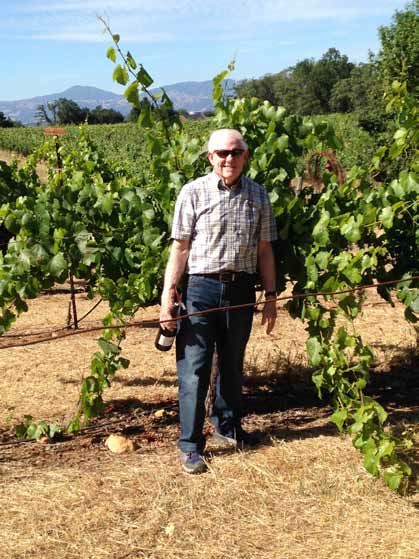 In the Bacigalupi Tasting Room, the group was all smiles as we sampled Bacigalupi’s outstanding 2014 Pinot Noir Rosé, 2012 Chardonnay and one of the new unreleased 2013 block-designated Pinot Noirs (left to right): Harry Peterson-Nedry, John Bacigalupi, the Prince, Patti Gaffney, and Pam Bacigalupi.
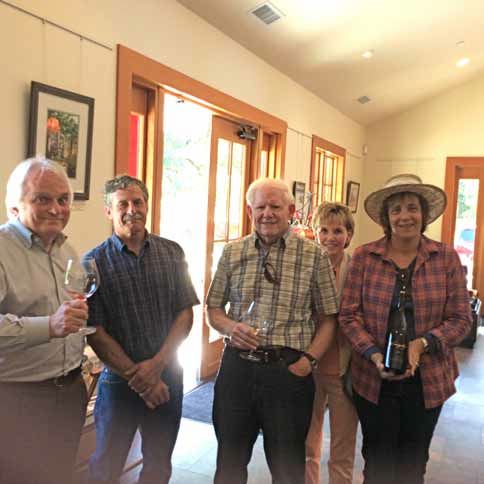
2012 Edge Hill Bacigalupi Vineyard Russian River Valley Chardonnay 14.3% alc., 414 cases, $115. Allocated to mailing list members. Fermented and aged in French oak barrels. · Light golden yellow color in the glass. This is a sensual wine with a perfume of cut yellow apple, honey, lemon oil and toasty oak. Round and polished on the palate, the uplifting flavors of lemon, white peach, apple are embellished with oak seasoning. Impeccably balanced, and thoroughly satisfying, previously hidden nuances seem to appear with each sip. Even better the following day from a previously opened and re-corked bottle. I believe this is easily a 15-year wine. Score: 97
The group capped off the night with dinner at Valette Restaurant in Healdsburg. Chef Dustin Valette, originally from Sonoma County, honed his craft at Aqua in San Francisco, Bouchon in Napa Valley and Dry Creek Kitchen in Healdsburg. His forte is pairing his cuisine with Sonoma County wine. We dined on Chef Vallete’s “Trust Me” tasting menu of four courses. He presented three different options for each course so everyone could sample other wine matches. Combined with wines from heritage Sonoma County vineyards, this was an absolutely wonderful dining experience The dinner wines: 2012 Merry Edwards Russian River Valley Sauvignon Blanc Magnum (40% of the grapes come from vines planted in 1979 at Martinelli Home Ranch, the remainder from Shone Farm 1985, Marino 1997, Meredith Estate 2004, and Dutton-Jewell 2005) 2008 Benovia Cohn Vineyard Sonoma County Pinot Noir 2010 Benovia Cohn Vineyard Sonoma County Pinot Noir 1997 Martinelli Jackass Hill Vineyard Russian River Valley Zinfandel (vines planted on St. George rootstock in 1887 by Guiseppe Martinelli in Forestville; the steepest non-terraced vineyard in Sonoma County with a 60-degree slope)
Rochioli Vineyards & Winery West BlockSpending an hour with Joe Rochioli, Jr., was a highlight of our trip. A humble, but proud man, Joe possess an indefatigable devotion to his vineyard and his personal history is marked by numerous notable achievements that inseparably link him to the history of winegrowing in the Russian River Valley. Now 81 years old, and hobbled by recent knee surgery, he still is active in the management of his vineyards. Considering he grew up in a very poor Italian-American immigrant family that lived completely from the land, struggled in the early years of school because he could not speak English, it is remarkable that was able to initiate a remarkable number of viticultural innovations that led to his unprecedented success and notoriety in the wine industry.
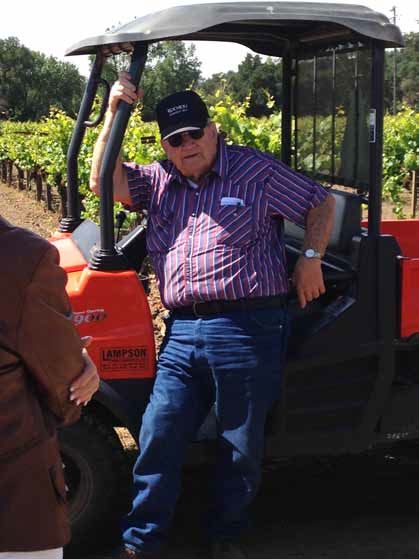 To understand the significance of Rochioli Vineyard West Block, it is important to review the historical circumstances that led to the planting of this vineyard. The Rochioli family arrived in the United States in 1912. Joe’s father, Joe, Sr., was sent to an orphanage at a young age, and since he had no name, he was given the name “Rochioli,” a word in Italian that had no meaning. Joe, Jr., was born in Sebastopol in 1934, and four years later the Rochioli family moved to the 125-acre Fenton Acres ranch adjacent the Russian River in Healdsburg where Rochioli Vineyards is located today. The farm was initially leased to Joe, Sr., who eventually bought portions of the ranch over time. The large farm was planted to hops, fruit, grapes ( a typical Italian field blend of Alicante Bouschet, Zinfandel, Petite Sirah, Sauvignon Vert and Black Malvasia), prunes and vegetables. By age 12, Joe, Jr., was doing a man’s work, lifting 60 pound sacks of hops in the hop kiln. When the hops business declined in 1953, hops were taken out and Blue Lake string beans planted and soon Joe, Sr., became one of the largest string bean growers in California. The old grapevines that dated to the 1890s were ripped out in 1957, and French Colombard was planted with two rows of beans planted on stakes between each row of grapevines. By the time Joe, Jr., returned from attending college at Cal Poly San Luis Obispo in 1959, Joe, Sr., had acquired the entire 162 acres. Joe, Jr., had read and researched grape varieties, and wanted to plant additional vinifera varieties, but his father and uncle were reluctant because wine grapes produced small crops and only returned $50 to $70 a ton at the time. Joe, Jr., finally talked his father into planting Sauvignon Blanc in 1959. (Cabernet Sauvignon was also planted but did not perform and was pulled out in the 1970s) Joe, Jr., traveled to the University of California at Davis in a 1947 Ford pickup to look at Sauvignon Blanc that was planted there to multiple clones. He walked the rows and tasted the grapes, finally deciding on one particular row where the grapes tasted the best. 10 acres of Sauvignon Blanc were planted and today, Rochioli Sauvignon Blanc has won more awards than any other wine Rochioli produces. The clone at Rochioli Vineyard forever remains a mystery as the Sauvignon Blanc vines at the University of California at Davis were eventually pulled out. By the early 1960s, farm labor was difficult to find and the string beans had all been pulled out at the ranch. Joe, Jr., begged his father and uncle to try Pinot Noir. He had done enough research to indicate to him that the grape would do well on the Rochioli ranch. Joe, Jr.’s father wanted to plant “early Burgundy,” a Gamay clone that was vigorous and more profitable, but produced wines that were more like a rosé.” Joe, Jr., said, “No way was I going to plant that stuff!” After Joe, Sr., died in 1966, Joe, Jr., used a tractor to pull out the French Colombard and some Cabernet Sauvignon that had been planted, and planted in their place Pinot Noir. His neighbors thought he was crazy. Since there was no Pinot Noir budwood readily available, Joe, Jr., sought out a Frenchman who had plantings south of St. Helena in the Napa Valley. He was met with resistance from the owner who reluctantly gave him some “suitcase” Pommard budwood from his vineyard. In 1968, Joe, Jr., planted 4 acres of Pinot Noir in what was to become known as East Block, named for the area east of the telephone pole on the property. This was one of the earliest plantings of Pinot Noir in the Russian River Valley. In 1969, he acquired the shares of the ranch owned by his brother and sister, and became the sole owner of Rochioli Estate. In 1970, 4 more acres of Pinot Noir were planted in what has become known as West Block, using budwood from Karl Wente’s estate vineyard in Arroyo Seco (Joe, Jr., told me the year was 1970, but many references and the winery’s website state the year as 1969). Joe, Jr., says that he insisted that Wente sell him cuttings from his most special French Pinot Noir vines and he paid 10 cents a bud, a huge expense at the time. A team from University of California at Davis has looked at the original Pinot Noir plantings at Rochioli Vineyards, and determined that they are one or more Pommard field selections. The West Block plantings were typical for the era with a 14 foot spacing between rows and 8 foot spacing between the vines (see current photo below). The rootstock is phylloxera resistant AxR#1.
 West Block is often referred to as the “mother block” because cuttings from this block were subsequently used to establish several other Pinot Noir blocks on the Rochioli ranch, Allen Vineyard across Westside Road from Rochioli Vineyard (first planted in 1970 with later plantings from West Block), and many other vineyards in the Russian River Valley. The heavily virused East Block vines were completely replaced with West Block cuttings after the 2008 vintage and a number of vines have been replaced in the West Block as well. West Block is now one-third its original size. In 1979, Joe, Jr., began selling some West Block Pinot Noir to Williams Selyem, before that famous winery had become bonded. Burt Williams recalls that Joe, Jr., sold him the Pinot Noir grapes for $550 to $600 a ton. Williams Selyem made Rochioli Vineyard famous, when in 1987, the 1985 Williams Selyem Rochioli Vineyard Russian River Valley Pinot Noir, made from West Block grapes, won the Sweepstakes at the California State Fair Competition and became one of the most seminal wines in the history of California Pinot Noir. Williams Selyem continued to source West Block grapes until the winery was sold in 1997, after which time Williams Selyem received grapes from the River Block section of Rochioli Vineyard. Cuttings from West Block are no longer given away or sold. A beautiful cluster of West Block Pinot Noir is shown below:
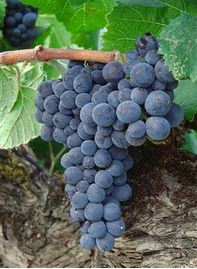 A J. Rochioli West Block-designated Pinot Noir was first offered in 1999: 400 cases, $65. Current production is about half that amount, and the price has risen to $125. The wine is allocated to devoted mailing list customers. Your best option is to buy the wine on the secondary or auction marketplace.
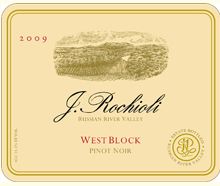 Tasting at Rochioli Vineyards & Winery:
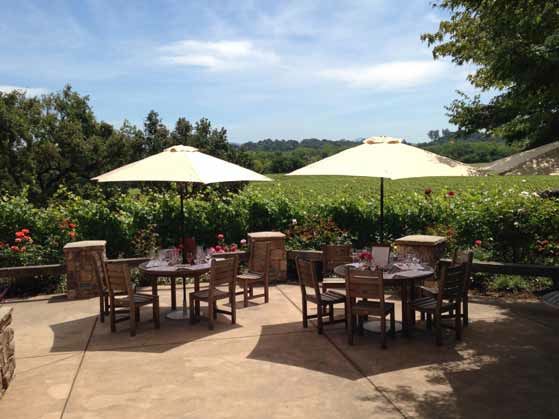
2011 Rochioli Russian River Valley Blanc de Noir 12.5% alc., $60. Inaugural bottling. 100% Pinot Noir. · A superb sparkling wine with a fine bead, a thoroughly dry and refreshing palate, and a clean, refreshing finish that mixes citrus and berry notes. This unique wine is sold through the tasting room currently. Score: 92
2014 Rochioli Estate Russian River Valley Rosé $28. 100% Pinot Noir. · This is a substantial rosé with plenty of strawberry, cranberry, cherry and peach fruit to satisfy. It is crisp and bright but has enough fruit and structure to pair with substantial foods. Score: 89
2013 Rochioli Estate Russian River Valley Chardonnay $42. · Barrel fermented, 100% malolactic fermentation. This wine sports a good tug of oak in a lush style featuring tropical and citrus fruits. Score: 89
2014 Rochioli Estate Russian River Valley Sauvignon Blanc 14.5% alc, 1,380 cases, $28. Original 1959 planting accounts for 44 percent of this wine. · This gorgeous wine offers an explosion of fruit on the nose and palate including lemon and white peach with accents of verbena and herbs. Very little, if any, grassiness. Fresh and satisfying with uncommon length on the finish. An Old Vine Sauvignon Blanc is also offered produced solely from plantings established in 1959. ($48). Score: 92
2013 Rochioli Estate Russian River Valley Pinot Noir $56. · Elegant and lighter in this vintage, with juicy flavors of red cherries and berries and spice, framed by modest tannins. Forward drinking and easy to like. Score: 90
2013 J. Rochioli West Block Russian River Valley Pinot Noir 14.3% alc., $125. · Moderately dark reddish purple color in the glass. The nose is highly seductive, with bright aromas of Bing cherry, purple grape, cola nut and cake spice. Stunning entry and mid palate exuberance with plenty of intense black cherry fruit flavor that really perks up the senses. Luscious, but not the least bit jammy, with balanced fine-grain tannins, a very appealing smooth texture, and notable old vine persistence on the finish. When tasted the following day from a previously opened and re-corked bottle, the wine still had plenty of showy, intense cherry fruit with a hint of sassafras and cola. A well-bred, special wine with a pedigree. Score: 92-93
2001 J. Rochioli West Block Russian River Valley Pinot Noir 14.2% alc., 400 cases, $65. Brought to the tasting from my cellar. · Slight bricking of rim. The wine has aged nicely, offering notes of leather, fig and burnished cherry on the nose. The tannins have softened, the wine is silky in texture, and offers a savory herb, spice and black cherry profile. Best to drink up but will hold a few years. Score: 90
Lynmar Estate Quail Hill VineyardThe Quail Hill Estate Vineyard Block 2 was first planted in 1974 (the Lynmar website says 1971 but the winery’s vineyard manager, Jason Sailing, told me that he confirmed with Tom Dehlinger who assisted in the acquisition of the cuttings that it was 1974) and has some of the oldest Pinot Noir vines in the Russian River Valley. These vines are some of the first established in the Russian River Valley with budwood from Joe Swan and is the only remaining block from the original plantings. A phased replanting involving 71% of the vineyard was undertaken in 1996, but select heritage blocks including the 2+ acres of Swan selection Pinot Noir planted in 1974 were retained. An additional 1.2 acres of Swan selection was planted in 1997 as Block 12, using budwood sourced directly from the original vines. The grapes from these original vines were sold to Tony Soter and Merry Edwards, until Lynmar began its own winemaking activity in the early 1990s. The Swan selection vines are in Block 2 and in Block 12 as shown in the map below. The photo shows the winery in the distance with Block 2 in the far distance and Block 12 in front of the winery.
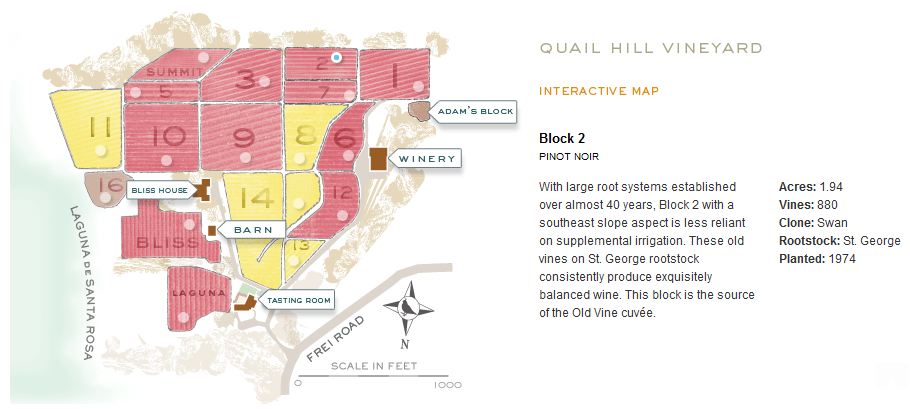
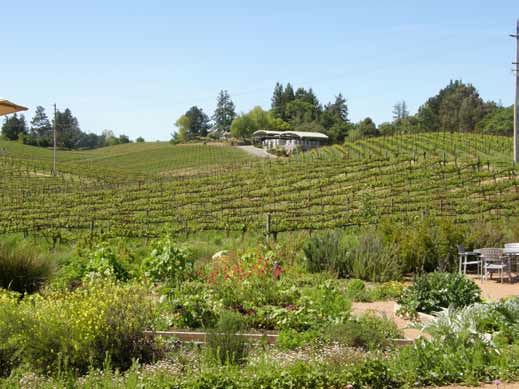 The Swan selection grapes have been a part of Lynmar’s Quail Hill Cuvée and Quail Hill Vineyard wines but were bottled separately as an Old Vines Pinot Noir for the first time in 2009. The 2012 Quail Hill Vineyard Old Vines Pinot Noir was a glorious wine when tasted in barrel and later in bottle in July 2014, and given a score of 95 (one of my 2014 All-American Pinot Noirs). The wine is currently sold out but a magnum is available ($185).
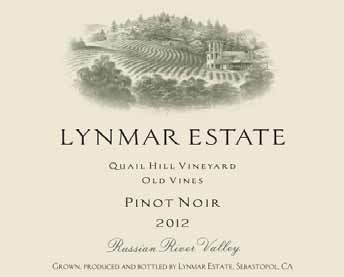 The legendary Joseph (Joe) Swan first planted Pinot Noir, along with Chardonnay and Cabernet Sauvignon, beginning in 1969, replacing a 13-acre plot of Zinfandel on Laguna Road in the Santa Rosa Plain area of the Russian River Valley that he acquired in 1967. It was Joe’s friend, Andre Tchelistcheff who advised him to plant Burgundy varieties on this site. According to current J. Swan proprietor and winemaker, Rod Berglund, the budwood for the original Pinot Noir plantings probably came from Martin Ray’s vineyard (now Mount Eden) in the Santa Cruz Mountains, originally brought into this country from France by Paul Masson. The budwood was obtained from the Experimental Station in Oakville. Some nursery selections were also planted but later abandoned. Joe marked the most redeeming vines in his vineyard and grafted the nursery selection roots over from wood he deemed to be the best. There were also DRC “suitcase” selections planted that were given to Joe as a gift by an unnamed individual many years ago (exact dates unknown). The resulting vine mix was later named the “Swan clone” by Francis Mahoney, the founder of Carneros Creek Winery. An additional block of Pinot Noir was planted just south of the original planting in 1974. Joe produced some very good and age worthy Pinot Noirs from his vines and helped to establish the credibility of Russian River Valley Pinot Noir. A Pinot Noir from the Swan vineyard, now called the Trenton Estate, was sourced entirely from the original 1969 and 1974 plantings from 1973 to 2002 (after 2002, some young vine fruit was added). The designation, “Trenton Estate,” did not appear until 1997. Cuttings from Swan’s vines were eagerly sought after, and because of Joe’s generosity, became widely distributed to other California vineyards as the Swan clone or Swan selection. Lynmar has one of the most spectacular hospitality centers in Sonoma County with tasting available in both an indoor and expansive outdoor venue. The photo below shows our happy group basking in the sunshine and seated for a Picnic Pairing 2015 lunch at Lynmar Estate (menu is reproduced below). Lynmar Estate has a full time chef and various food options are offered in the tasting venue.
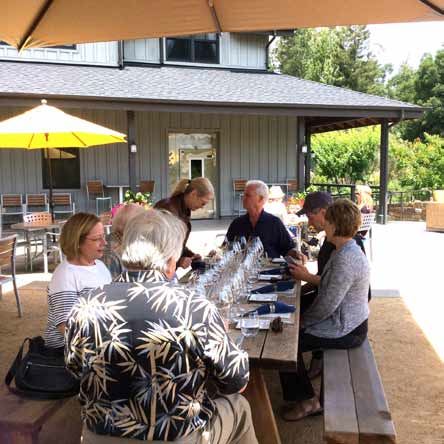
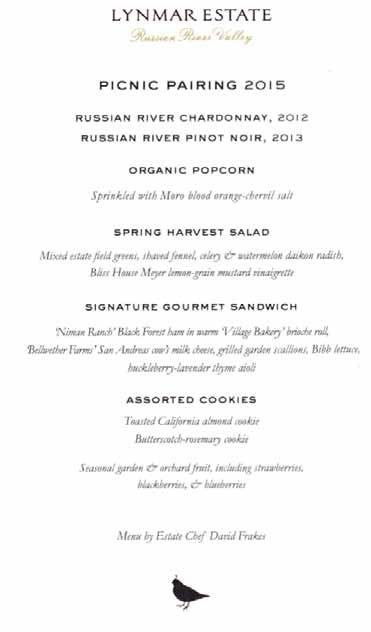 Lunch wines:
2012 Lynmar Estate Russian River Valley Chardonnay 14.2% alc., 843 cases, $35. A blend of Quail Hill Estaate and Sweeney Vineyard with a small amount of Zio Tony Vineyard. Aged 15 months in 32% new French oak barrels. Previously reviewed July 19, 2014. · Light gold color in the glass. Aromas of lemon curd, butterscotch, pineapple, green apple, baked pear and spice are echoed on the silky palate. Easy to like, with refreshing acidity, and complimentary oak highlights. Score: 89
2011 Lynmar Estate Quail Hill Vineyard Russian River Valley Chardonnay 14.1% alc., $55. Primarily Rued clone. · Light golden yellow color in the glass. A step up from the solid Russian River Valley bottling with more flesh, intensity and finish. Aromas of lemon oil and white peach lead to a very smooth palate of baked apple, peach and pear fruits accented with honey and caramel. Score: 91
2012 Lynmar Estate Quail Hill Vineyard Russian River Valley Pinot Noir 14.5% alc., 2,360 cases, $60. A blend of 14 clones from the estate vineyard. Aged 10 months in 37% new French oak barrels. Previously reviewed July 19, 2014. · Moderately dark reddish purple color in the glass. Deep aromas of fresh Bing cherry and baking spice. Mid weight flavors of dark cherry, cola and sarsasparilla with a touch of oak in the background. The tannins are suave and noble, and the finish is outfitted nicely with generous black cherry and black raspberry fruits. Score: 92
2013 Lynmar Estate Russian River Valley Pinot Noir 14.2% alc., 2,359 cases, $40. Sourced from six vineyards including the Quail Hill Vineyard and Susanna’s Vineyard. Aged 10 months in 42% new French oak barrels. · Moderately dark garnet color in the glass. Still young and a bit shy on the nose with scents of black cherry and cake spices. Middleweight flavors of cherry pie glaze, strawberries, cola and spice are framed by modest tannins. Score: 89
Winemaker Shane Finley (formerly of Kosta Browne) stopped by to talk about Lynmar wines and offered a taste of a few special bottles (see photo of Shane below). I must admit, I was having too many laughs and enjoying Shane’s company too much to comment specifically on the wines he brought. Just say that he is crafting a superb lineup of wines at Lynmar Estate, and if you visit, try to spend some time with him.
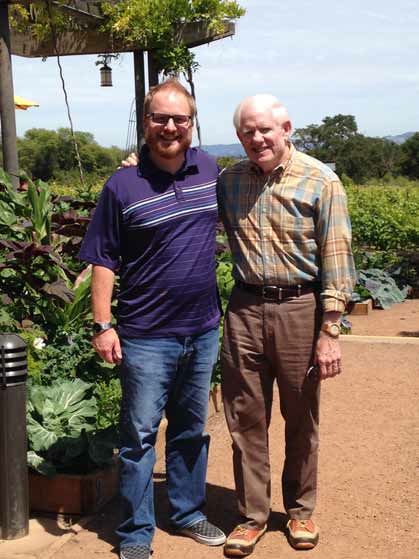
Dehlinger Winery Old VinesTom Dehlinger (DAY-leen-ger) was born on the East Coast, but grew up in Berkeley, California, and earned a degree in biochemistry at the University of California at Berkeley. He pursued graduate work in enology and food science at the University of California at Davis for a year, leaving school to work in the wine industry, first as a lab technician at Beringer, then in winemaking positions at Hanzell and Dry Creek Vineyard. He was only 26-years-old when, in 1973, he set upon a career as an independent winegrower and winemaker. Russian River Valley Pinot Noir was in its infancy in 1973. Joe Swan had planted Pinot Noir in the Vine Hill region of the Russian River Valley four years prior using cuttings from Mount Eden and budwood from Burgundy and released his first Pinot Noir. Joe Rochioli, Jr., was harvesting his early viable crops from East Block and West Block Pinot Noir plantings on Westside Road first established from 1968 to 1970. Interestingly, there is little to indicate that Joe Swan and Joe Rochioli, Jr., knew of each other’s early plantings. Davis Bynum, working out of an old hop mill on Westside Road, released his 1973 Rochioli Vineyard Russian River Valley Pinot Noir, the first vineyard-designated wine from the Russian River Valley. The 1973 Davis Bynum Winery Rochioli Vineyard Pinot Noir and 1973 Joseph Swan Pinot Noir were probably the first Pinot Noirs to carry the words “Russian River” on the label, ten years before the Russian River Valley AVA was approved. Russian River Valley Pinot Noir was beginning to happen, and into this stage came Tom Dehlinger, another visionary, who, along with his father, invested in a 45-acre ranch on Vine Hill Road in Sebastopol. Tom had well-defined ideas about winegrowing and was driven to plant his own vineyard. He spent the spring of 1974 bench grafting and callusing over 10,000 vines in a rented heated basement in Bolinas in Marin County. By summer, he had planted the fledgling vines in a nursery space in Dry Creek Valley. At the same time, he removed Gravenstein apple trees from his neglected hillside property. With guidance from Joe Swan, Warren Dutton and Forrest Tanzer, Tom planted the first 14 acres of vines on his property on Vine Hill Road at the intersection of Gravenstein Highway in the spring of 1975. The original 1975 Dehlinger Pinot Noir plantings consisted of 4 acres of Pommard, and Martini clones with a smaller selection of cuttings from Joe Swan’s vineyard. When Tom and his spouse Carole were planting the original vines, they ran out of vines and turned to Joe Swan to supply vines to fill out the vineyard.
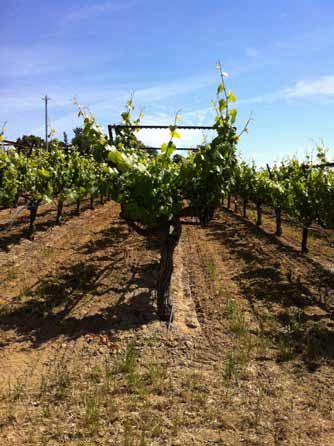 The initial Pinot Noir plantings were on AxR#1 rootstock using a 10 foot by 8 foot spacing in vogue at the time. Irrigation was achieved with overhead sprinklers. The vines were trained on a single wire and pruned to two fruiting canes but it was soon evident that vine growth was too vigorous and the vines lacked balance. Viticulturist Marty Hedlund was hired to supervise further plantings and institute a program to overcome vine imbalances. A new split-canopy vertically shoot positioned Lyre trellis system was retrofitted in 1993. The Dehlinger old Pinot Noir vines are pictured above. After a few years, it was evident that the three clonal types were quite different in their growth patterns and eventually were harvested and processed separately. Tom recognized the differences in terroir within the vineyard, and combined with the clonal differences, led him to become an early champion of separately picking and vinifying small lots of grapes from different portions of the vineyard. The old vines are planted in both Goldridge and Altamont soils. When bottlings labeled “Old Vines” have been produced, they can originate from either soil types. Over the past 21 years, an “Old Vines” bottling sourced from the original plantings has been offered in certain vintages (2000, 2001, 2002 and 2009 from Altamont soil, and 1994, 2007 and 2012 from Goldridge soil.
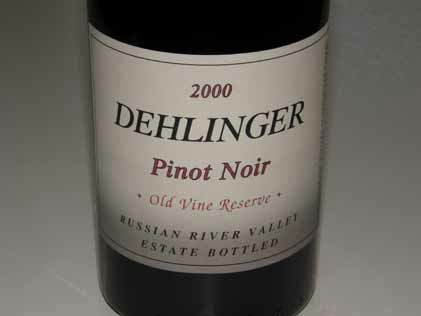 Eva (in red shirt), Tom’s daughter, led us on a tour of the old vine portion of the Dehlinger Vineyard. She has a degree in Earth Systems Science from Stanford University, and subsequently studied viticulture at the masters level at the University of Burgundy in Dijon. She works side-by-side with Tom in crafting the Dehlinger wines and management of the vineyards.
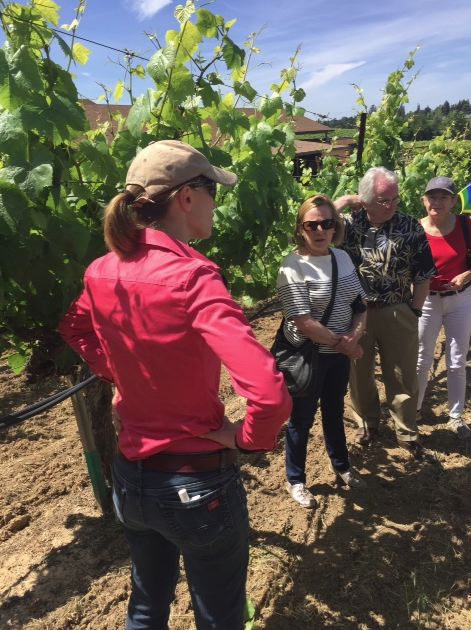 Eva pulled two barrel samples of 2014 Pinot Noir to compare: one from old vines planted in Altamont soil and one from new vines planted in Altamont soil (clone 943 on 420A rootstock). The winemaking regimen was similar for both wines. I may have been influenced by the old vines designation since we didn’t taste them blind, but I definitely preferred the old vines bottling because of its added complexity and more lengthy finish.
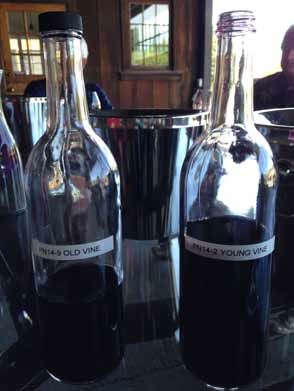 Eva told me that wines made from Dehlinger’s old vines are often some of her favorites. “For whatever reason, they often tend to be complete on their own, well balanced, and satisfying. That said, I don’t believe that a vine needs to be old to make compelling wine. The young vine wine we tasted was also quite enchanting and I am thrilled with the way our young vine wines have turned out.” Eva went on to talk more philosophically about old vine wines. “What is special to me about the old vine wines is broader than just the wine in the glass. It is the context and history of the old vines that is so important. I’m moved just thinking about all the seasons that the vines have lived through, all the people who have cared for them, and all the vintages they have offered us fruit. It makes me think of the Rose in the Little Prince: it’s the time that we invest in our loved ones (and loved vines) that makes them so unique.
Pellegrini Wine Co. Olivet Lane VineyardThe Pellegrini family has been growing wine grapes and producing wine in Sonoma County, California, for four generations. Current patriarch, Robert, established Olivet Lane Vineyard upon the urging of his parents, Vincent and Aida. In 1973, Vincent acquired a 70-acre apple, plum and olive orchard on West Olivet Road between River Road and Guerneville Road in Santa Rosa, an area of the Russian River Valley known as the Santa Rosa Plain. Robert was fresh out of school, had just returned from a tour of Burgundy, and was intrigued by the idea of planting Pinot Noir on the family’s newly acquired land. Robert planted both Pinot Noir (20 acres) and Chardonnay (40 acres) in 1975, with an emphasis on Chardonnay since that grape was in much more demand than Pinot Noir at the time, and was earning twice the revenue. Robert and Vincent brief considered budding over the Pinot Noir to Chardonnay but decided otherwise. This turned out to be a good decision since by 1987, the first year Pinot Noir grapes were sold to Burt Williams and Ed Selyem, the potential for premium Pinot Noir was clear. The Olivet Lane Vineyard was named after the olive trees which line the vineyard’s east entrance. Robert says today, “I was just naive enough at the time to think it would work." Martini clone was planted on AxR#1 rootstock with wide row and vine spacing in favor in the 1970s. The vineyard continues to thrive despite the threat of phylloxera and has now seen almost 40 vintages. The photo below shows one of the old vines near harvest in 2009.
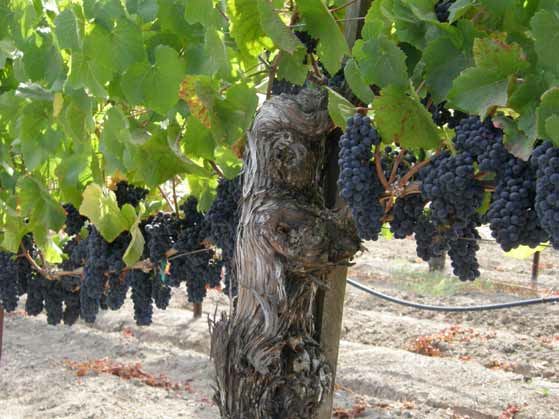 Through the years, grapes from Olivet Lane Vineyard have been sourced by such notable wineries as Brogan Cellars, Gary Farrell, Kosta Browne, Merry Edwards, Paul Hobbs, WesMar and Williams Selyem. With the 2013 vintage, Robert and his direct family assumed sole proprietorship of the winery and vineyard, and an Olivet Lane Vineyard Pinot Noir and Chardonnay have recently been released, marking a new and bright incarnation of a Russian River Valley heritage estate. On Friday evening of our three-day tour of heritage vineyards, Robert Pellegrini, along with his family and winemaker, Lynn Krausmann, hosted a family style dinner at Canneti Roadhouse Italia in Forestville. The menu included an antipasto selection of cured meats and crostini, a Risotto alla Milanese with saffron and Pecorino cheese, a chestnut-fed pork roast over rosemary potato fries, and a cherry crostata for dessert. The photo below shows Robert next to the lineup of Olivet Lane Vineyard wines served at the dinner.
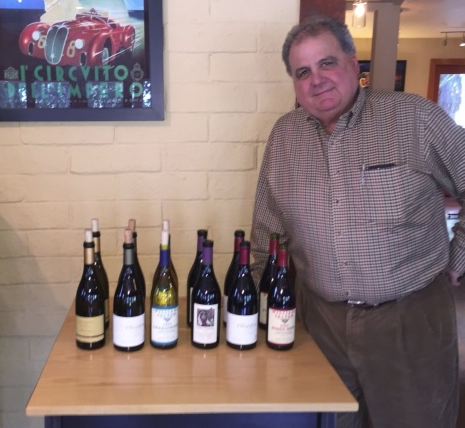 Dinner wines:
2013 Olivet Lane Estate Russian River Valley Chardonnay 2013 Williams Selyem Olivet Lane Vineyard Russian River Valley Chardonnay 2012 Gary Farrell Olivet Lane Vineyard Russian River Valley Chardonnay 2013 Olivet Lane Estate Russian River Valley Pinot Noir 2013 Merry Edwards Olivet Lane Vineyard Russian River Valley Pinot Noir 2013 Williams Selyem Olivet Lane Vineyard Russian River Valley Pinot Noir The Olivet Lane Estate wines were clearly my favorites and several others at the table agreed.
Hanzell Vineyards The Ambassador’s 1953 VineyardOn Saturday morning, our group traveled to Hanzell Vineyards, located on the western side of the Mayacamas Mountains overlooking the town of Sonoma, California. Founded by Ambassador James D. Zellerbach in 1953 with a vision to produce wines equal to the finest in the world, the estate was purchased by the de Brye family in 1975. The 200-acre Sonoma Valley property includes 46 planted acres and is home to the oldest continuously producing Chardonnay and Pinot Noir vines in North America: The Ambassador’s 1953 Vineyard. The Ambassador’s 1953 Vineyard consists of 4 acres of Mount Eden Pinot Noir and Wente Chardonnay on St. George rootstock. In the 1950s, Pinot Noir budwood was hard to come by, but a Napa Valley vineyard owner by the name of Martin Stelling reputedly had a Pinot Noir selection in his To Kalon Vineyard. It has been rumored to have been originally sourced by Santa Cruz Mountains vintner Martin Ray via Paul Masson, and possibly came from Clos de Vougeot. According to Hanzell legend, Stelling was unwilling to part with any budwood, and founding winemaker Brad Webb went on a clandestine mission under cover of darkness to Napa in 1952 and brought back cuttings. Another, more plausible story, posted on the Hanzell website, is that University of California at Davis Professor A.J. Winkler selected vines from which To Kalon Vineyard manager Ivan Schoch cut the budwood. Schoch was also Hanzell’s vineyard manager when Ambassador Zellerbach planted Hanzell Vineyards in 1953, and it was Schoch who introduced the To Kalon Vineyard cuttings to Hanzell Vineyards. Many of the new plantings at Hanzell have been propagated from those original cuttings that had a Martin Ray connection. Now the selection is known as the Hanzell clone. The clone has a high incidence of millerendage, berries for which pollination has failed and grapes develop without seeds. Because of the lack of seeds, the grape’s growth is restricted to the size of peas. Wine made from such small grapes can have complex flavor and abundant tannin for greater aging potential. The terraced and contoured vine rows have a western exposure and slopes of up to 15%. Soils are Raynor- Montana Complex. The photo below shows The Ambassador’s 1953 Vineyard and one of the old Pinot Noir vines.
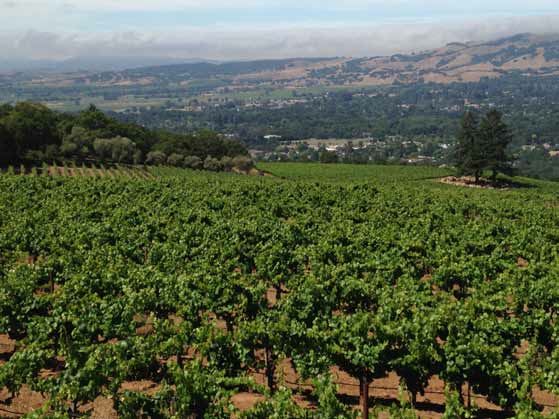
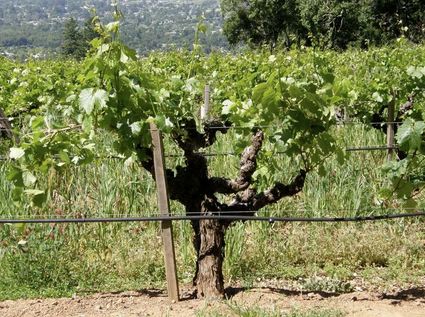 After a tour of The 1953 Ambassador’s Vineyard, the new winery and the caves led by Zakk Murphy, the estate’s educator, the group convened in the old winery for a tasting of Hanzell wines with Zakk and John Buckey, CSW, Director of Sales and Marketing.
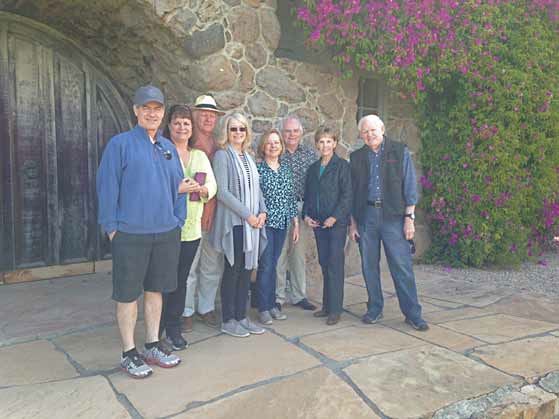
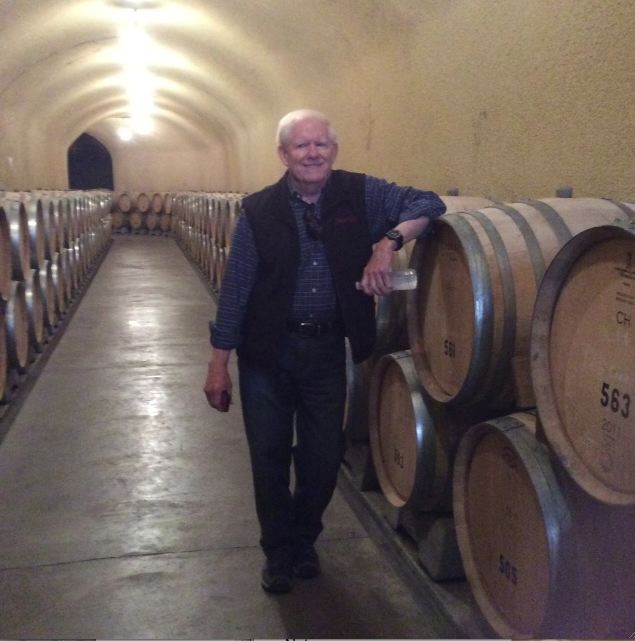 Wines tasted (unfortunately, I misplaced my tasting notes that I took at the winery but if you check the reviews for Hanzell in the PinotFile, you will realize that I greatly value these wines which are consistently among California’s finest examples of Pinot Noir and Chardonnay): 2013 Hanzell ‘Sebella’ Sonoma Valley Chardonnay $36 2012 Hanzell Sonoma Valley Chardonnay $78 Estate heritage clones. Aged 18 months total with 12 months in 33% new French oak barrels. 2012 Hanzell Sonoma Valley Pinot Noir $98 The Hanzell Ambassador’s 1953 Vineyard Sonoma Valley Pinot Noir is very limited in production and sold only to Exclusive and Private Ambassador’s Circle Members.
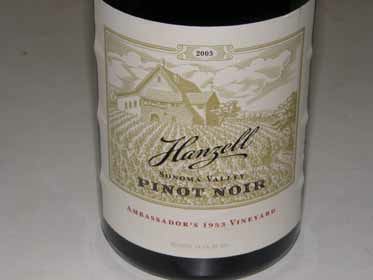 John had two surprises for us which he graciously shared, both of which we tasted blind: a 1975 Hanzell Sonoma Valley Pinot Noir in half bottle format and a 1974 Hanzell Sonoma Valley Pinot Noir in 750 ml format. No one in our group guessed the age of these wines for they showed much younger than they were. I misplaced my tasting notes, but I remember how impressed I was with both wines, especially the 1974 bottling which was still amazingly fresh and complex, offering rustic fruit flavors and enough structure to carry on for several more years.
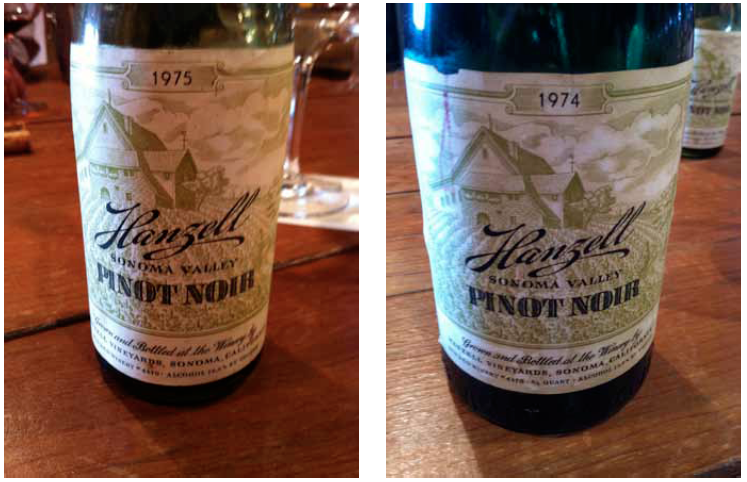
Patz & Hall Sonoma House Visit & Tasting with James HallJames Hall, Anne Moses, Donald Patz and Heather Patz formed their partnership in 1988, produced their first Chardonnay in 1994, and their first Pinot Noir in 1996 from Hyde Vineyard (see next feature on Hyde Vineyard). They source grapes from regions in California ranging from the Santa Lucia Highlands in the South to Mendocino County in the North. There are two vineyards they source Pinot Noir and Chardonnay from: Alder Springs Vineyard in Mendocino County and Hyde Vineyard in Napa Carneros. Although known for distinctive single vineyard bottlings, the Sonoma Coast appellation Pinot Noir is a consistent performer and best seller year after year. In 2015, Patz & Hall produced 24 wines, both still and sparkling, from Chardonnay and Pinot Noir. All Pinot Noirs are produced using whole cluster additions, usually 20 percent. To extract color and flavor components, a proprietary punch-over device is used to beak up the cap two to three times a day. All fermentation are performed with native yeasts. Most wines are composed only of free run juice. The wine is aged in French oak barrels, varying between 50 and 70 percent. Many of the vineyards that Patz & Hall source from are at least 20 years old (Alder Springs 1993, Brown Ranch 1992, Durell Vineyard late 1970s, Hudson Vineyard early 1980s, Hyde Vineyard 1979, Pisoni Vineyard late 1980s and Zio Tony Ranch 2000-2001-2006). Our group met James Hall at the winery’s Sonoma House, a beautiful hospitality center on Eighth Street, a short distance from the Sonoma Plaza. James is quite the storyteller, and we were all captivated by his reminisces of the region’s history. The tasting was accompanied by canapés by La Saison: Roasted Morel Mushrooms with Melted Shallots & Thyme Highway One Bechamel with Crispy Kale on Rice Cracker, Sage Chicken Salad with Rose Petals on Rice Cracker, Tea Smoked Duck on Rice Cracker, and Studio 761 Truffle Collection.
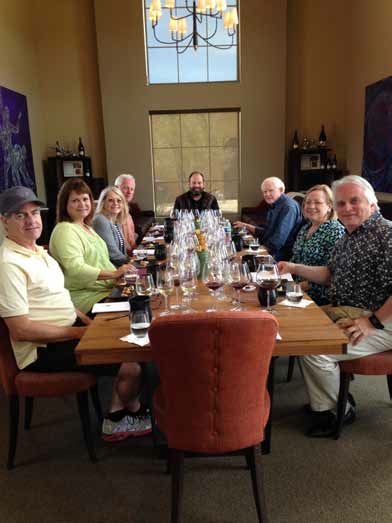 Wines Tasted:
2013 Patz & Hall Rued Vineyard Russian River Valley Chardonnay 350 cases, $55. Barrel fermented, 100% malolactic fermentation, aged in 35% new French oak barrels. · Nicely composed, with a core of citrus and apple fruits, a touch of honey and floral, slightly viscous on the palate, with a compliment of nutty oak, bright acidity and some finishing length. Score: 89
2013 Patz & Hall Durell Vineyard Sonoma Valley Chardonnay 14.2% alc., 375 cases, $55. · Light golden yellow color in the glass. Very appealing aromas of yellow peach, almond spread, and lemon curd. A little more richness and softness that the Hudson bottling, and more Russian River Valley in character, The flavors of yellow peach are accented with a hint of smoke, toast, and saline. The wine finishes with a lemony, saline theme that persists. Score: 93
2013 Patz & Hall Hudson Vineyard Carneros Chardonnay 14.2% alc., 375 cases, $55. James Hall calls Udson a “phenomenal farmer.” His father is the CEO of Exxon but he chose a different life path. His wines are sold primarily in Texas. · Light golden yellow color in the glass. A stunning wine that satisfies in every way. Bright aromas of lemon, pear and brioche lead to a potpourri of apple, pear and citrus flavors that arrive with aplomb. Refined, vibrant and serious, this classy juice leaves behind a vivid honeyed citrus note on the uplifting finish. Very special. Score: 96
2012 Patz & Hall Brown Ranch Carneros Pinot Noir 400 cases, $70. Second of three year contract. · Moderately dark reddish purple color in the glass. Rich and ripe, with flavors of black cherry and blackberry, framed by firm tannins and spicy oak, ending with an intensely fruity and generous finish. Score: 90
2012 Patz & Hall Burnside Vineyard Russian River Valley Pinot Noir 13.2% alc., 425 cases, $75. This vineyard is farmed by the Martinelli’s and Patz & Hall has produced Pinot Noir from this source since 2001. · Moderately dark reddish purple color in the glass. Nicely perfumed with hi-tone scents of crushed dark red berries, black cherry and brioche. The mid weight flavors echo the nose with an added hint of smoke and herbs. The engaging fruit comes to the front over time in the glass. A bit rustic and rugged upon opening, with a rush of tannins, but showing much better harmony and refinement the following day from a previously opened and re-corked bottle. Decant now or cellar before enjoying. Score: 90
2012 Patz & Hall Chenoweth Ranch Russian River Valley Pinot Noir 14.8% alc., 925 cases, $60. This vineyard is farmed exclusively for Patz & Hall who have produced a vineyard-designated Pinot Noir since 2004. · Moderate reddish purple color in the glass. Heavenly aromas of dark stone and berry fruits with a hint of spice, mocha and vanillin. Intensely flavored with a sappy core of sweet boysenberry, blackberry and pomegranate fruits framed by muscular tannins. When tasted the following day from a previously opened and re-corked bottle, the tannins had noticeably softened. Cellar this beauty for a celebration down the line. Score: 91
Hyde VineyardOur group followed James Hall to nearby Hyde Vineyard where we spent a delightful time with Larry Hyde, one of California’s legendary winegrowers and viticulturists, and his spouse Beta. Larry Hyde, now 69, currently farms 205 acres in the Hyde Vineyard with many distinct blocks located in Napa Carneros just off of Sonoma Highway 12/121. Larry attended University of California at Berkeley and studied chemistry and entomology, eventually devoting himself to learning about vineyards. Larry’s experience with various vineyards in the North Coast region (he spoke fluent Spanish and easily assimilated into the winegrowing culture) including Cuvaison, Ridge Vineyards, Stag’s Leap Wine Cellars and Joseph Phelps, led him to this site that had gentle sun exposure and cool maritime influence. Larry’s late father, Richard, Sr., bought the land that now makes up Hyde Vineyards in 1979.
 His experiments with clones, rootstocks and vine row orientation span over 33 years. He has helped to develop two important grape selections: Hyde-Wente Chardonay and Hyde-Calera Pinot Noir. The original plants were oriented east-west in 1979 because that was what the neighbors were doing. The grapes did not receive ideal sun exposure and long with some phylloxera led Larry to replant the vines in a north-south orientation on southeast-facing, rolling hills. The vines are sustainably and organically farmed. The soils are heavy, well drained red clay loam about 36 inches deep with impenetrable clay subsoil which limits vine vigor and crop yield. The original "big" Hyde Vineyard consists of 152 acres. In addition, Cuttings Wharf has 15 acres, Los Carneros 10.5 acres, and Bay View Avenue two vineyards of 12.5 and 15 acres. Larry suffered a stroke at the age of 35 when a car hood fell onto his head, leaving him partially paralyzed on the left side, but this has not deterred him from success. Photo below of Larry (left), Rusty and James Hall. Hyde Vineyard is planted to eight different varieties (including Pinot Noir, Chardonnay, Sauvignon Blanc, Semillon, Syrah, Cabernet Franc, and Cabernet Sauvignon), with ten different types of Pinot Noir and six varieties of Chardonnay, and the vineyard supplies grapes to 25 producers including Aubert, Duckhorn, HdV, Paul Hobbs (the 2012 Paul Hobbs Hyde Vineyard Pinot Noir recently won the 2015 Pigs & Pinot Tasting), Patz & Hall, Ramey, Kistler, Mondavi, Ramey Wine Cellars, Selene and Stomping Girl Winery. All wineries pay by the acre. Here is a map of the Hyde Vineyard showing the Pinot Noir planted:
 Patz & Hall (Hyde’s largest ton buyer) has worked with fruit from Hyde Vineyard since 1990, and has crafted single vineyard Pinot Noir and Chardonnay bottlings since 1996. The first Patz & Hall vineyard-designated Pinot Noir was from Hyde Vineyard. Several sections of the vineyard have been planted exclusively for Patz & Hall.
 Aubert de Villaine, co-owner of Domaine de la Romanee-Conti, and a relative of Larry’s by marriage, is a viticultural consultant at Hyde Vineyard and a partner in the HdV Winery along with Larry Hyde. Along with HdV’s French-born winemaker, Stephane Vivier, Larry has absorbed considerable French input. In 2011, Chris Hyde assumed the role of general manager at Hyde Vineyard and is the winery relations contact for the 35 clients who purchase Hyde Vineyard fruit. He also has worked on construction and financing of a winery facility built in 2014 on one of the family’s vineyards at the intersection of Highway 12/121 and Los Carneros Avenue (see Cuttings Wharf below). Hyde Wines (originally named Larry Hyde & Sons) is a collaboration between Larry Hyde and his sons Chris and winemaker Peter Hyde. The first Pinot Noir was released from the 2009 vintage, and Chardonnay has subsequently been added. The wines are source from Larry Hyde’s Chardonnay and Pinot Noir plantings south of Sonoma Highway:

2012 Hyde Hyde Vineyards Carneros Pinot Noir 14.9% alc., $65. · Moderate reddish purple color in the glass. Shy, but pleasant aromas of dark fruits, underbrush and seasoned oak. Full-bodied, fruit-centric, and quite ripe, with rich flavors of black plum, blackberry and cassis with an earthy, mushroom riff in the background. The texture is quite silky, the tannins are balanced, and there is some lingering and generous fruit on the finish. When tasted the following day from a previously opened and re-corked bottle, the wine was even more expressive on the nose and palate. Score: 91

Saturday Night Dinner BacchanalThe weekend wine immersion trip ended with a dinner prepared by talented, personal chef, Tiffany Friedmann of Butterroot, who specializes in creative dishes using seasonal, local and organic ingredients. The group gathered at a house in Sebastopol adjacent vineyards farmed by Balletto Vineyards in Sebastopol Hills. The five-course menu:
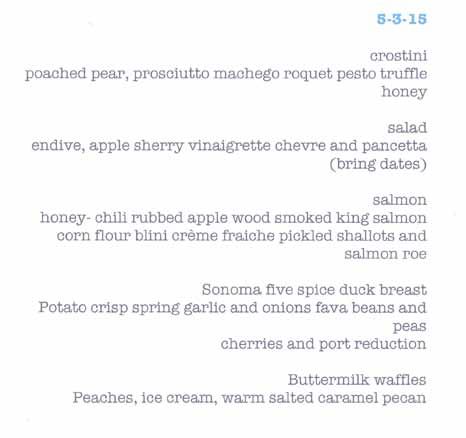
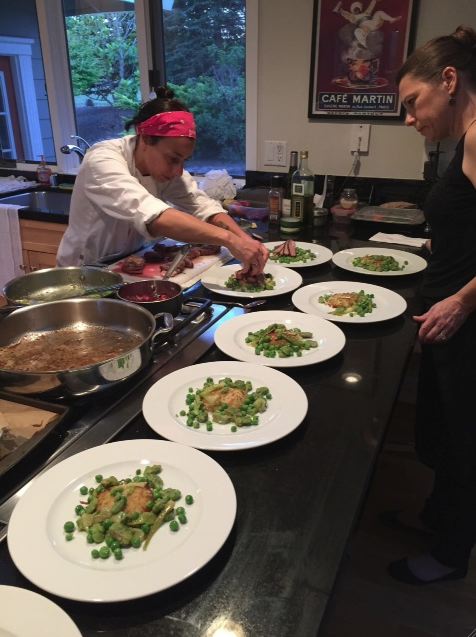
 Dinner Wines:
2004 Rochioli Russian River Valley Sauvignon Blanc 2007 Hanzell Sonoma Valley Chardonnay 2012 Stomping Girl Hyde Vineyard Chardonnay 2006 Williams Selyem Rochioli Vineyard Russian River Valley Pinot Noir 2001 Dehlinger Old Vines Reserve Russian River Valley Pinot Noir 2002 J. Rochioli West Block Russian River Valley Pinot Noir 2009 Alysian Rochioli Vineyard Russian River Valley Pinot Noor
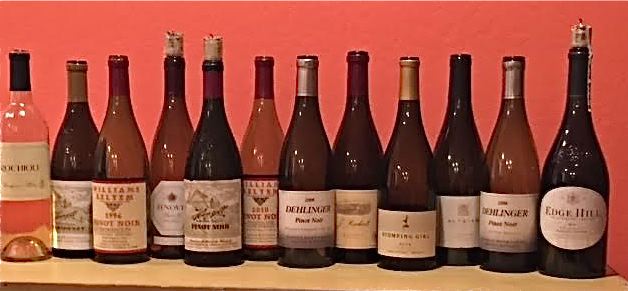
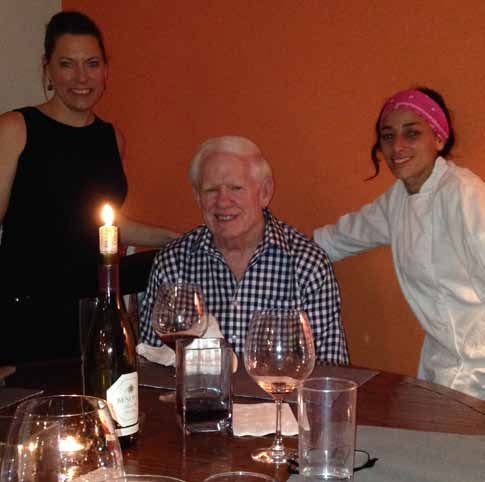 If you are planning a stay in Sebastopol wine country, I can recommend VRBO #249014. This is a very clean 3 bedroom, 2 bath, ranch style home surrounded by vineyards. The owner is very accommodating. For a special experience, hire Chef Tiffany Friedman to cook for you while you are in Sonoma County. A former Cutthroat Kitchen Champion, you can check out her personal chef company, Butterroot, at www.cheftiffanyfriedman.com.
Pinot BriefsAnderson Valley/Yorkville Highlands Barrel Tasting Weekend The weekend of July 25-26, 2015, enjoy unprecedented access to winery cellars, taste pre-release wines, and purchase futures of your favorites at a special barrel tasting weekend price. Participating wineries along Highway 128 will feature previews of new wines from Pinot Noir to Zinfandel, along with current releases from 11:00 am to 4:00 pm both days. The event is mellow and civilized, and only $20 for the entire weekend which includes a log glass. For tickets, visit www.avwines.com/other-events/ Carlton Crush Harvest Festival The Carlton Business Association presents the fourth annual Carlton Crush Harvest Festival on Saturday, September 12, 2015, from 10:00 am to 10:00 pm in downtown Carlton, Oregon. This growing event celebrates the unique culture of Carlton and Yamhill County. Live music and entertainment, a vintage car display, kids’ grape stomp and watermelon eating contests, wine thief competitions, and many wine, food and craft beer vendors. The annual Festival has become known as “the wine Olympics of Oregon.” Carlton is home to many noted winery tasting rooms. Admission and parking are free. For information, visit www.CarltonCrush.com.
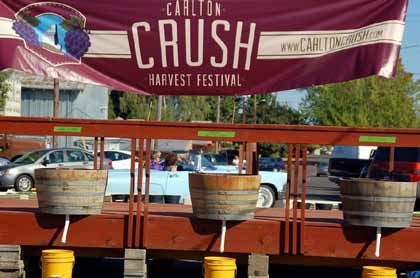 ‘Rockstar’ Winemakers Television Show A reality show called ‘Best Bottle’ is currently looking for aspiring winemakers to participate in a grudge match between California and Oregon according to the drinks business (June 5, 2015). Contestants (a.k.a. cellar rats) will be divided into two teams, one from California and one from Oregon and each team will have an established winemaker as a leader. The contestants will try to produce the “best bottle of wine.” The winning contestant will pocket $100k cash, a new car, and the chance to bottle one vintage under the “Best Bottle” label. Contestant entries must be received by July 1. Visit www.winebestbottle.com for the press release and details of the casting call. Percentage of Women Winemakers Slowly Increasing Recent research reported by Wine Business Monthly (June 2015), found that the number of women in head winemaking positions at California wineries has increased compared to the number of men in such positions over the past 15 years. The number of women winemakers still remains small at just under 15 percent. Researchers compared the number of women winemakers at the same set of wineries (480) in 1999 and 2014 and did not look at California’s total of 3,400+ wineries today. Other separate data was recently posted online that shows the percentage of California wineries by winemaker sex and region as of July 1, 2011, (excluding the few wineries with a male and female winemaker). The percentage ranged from 4% to 12% with the overall percentage 10%.
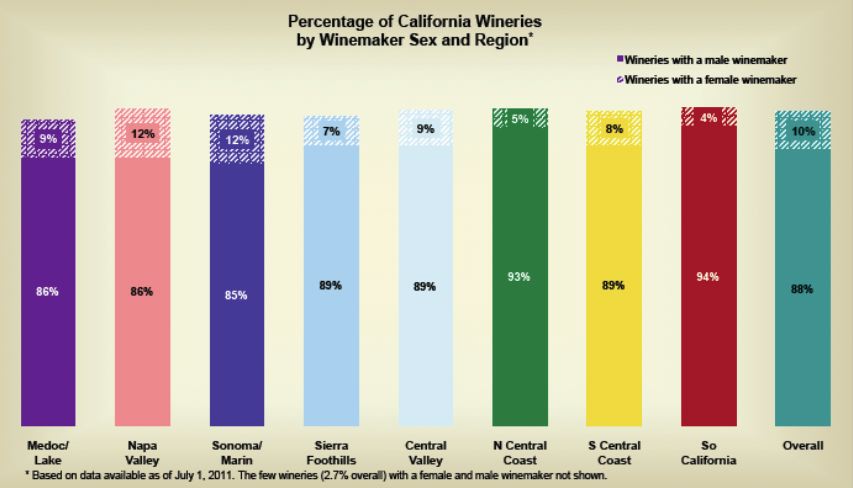 Siduri to Host Oregon Wine Tasting On July 8, 2015, from 5:00 pm to 7:00 pm, a large number of Oregon wineries will be pouring their wines at the Siduri Winery facility at 981 Airway Court, Suite E, in Santa Rosa. Wines will be paired with chef-prepared small bites. Advance tickets are $25 ($15 for wine club members) at Catherine.Robison@siduri.com. Participating wineries include Argyle, Soter, Bergström, Bethel Heights, Chehalem, Ponzi, Hammacher, Leah Jorgensen, Eyrie, Troon Trisaetum, Anne Amie, Alexana, Walt, Hawks View, Gran Moraine, J. Christopher, Fiddlehead Cellars, Cristom and Siduri Wines. Pre-IPNC Events (1) There are still a few spots available for the 35th annual Steamboat Pinot Noir Conference July 19-22, 2015 (winemakers only). Details at www.steamboatpinot.com. (2) Summertime ¡Salud! Pre-IPNC Dinner Thursday, July 23, 5:30 pm at Stoller Family Estate in Dayton, OR. A wine tasting reception featuring 14 acclaimed wineries from Oregon and beyond, followed by a family style alfresco dinner prepared by The Allison Inn & Spa Executive Chef, Sunny Jin. More information on this event and other pre-IPNC dinners can be found at www.ipnc.org/thursday.php. The pre-IPNC dinners may be attended by anyone whether they hold tickets to IPNC or not. Wine Folly Book on Presale If you have visited the Wine Folly website - www.winefolly.com - you know how helpful the graphics and charts are in understanding wine. Wine Folly: The Essential Guide to Wine by Madaline Puckette and Justin Hammack is a new, visual guidebook to wine that contains 230 pages of never-before-released wine infographics. The book will be released September 22, 2015, but can be preordered for 33% off at various book sellers including Amazon.com ($16.87).
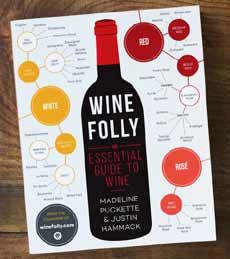 Expansion of Willamette Valley AVA The TTB published a notice of proposed rule making detailing the addition of about 29 square miles to the southwestern edge of the Willamette Valley. King Estate Winery, located in the proposed expansion area, submitted the petition which was supported by both the Oregon Winegrowers Association and the Willamette Valley Wineries Association. Occidental This is a new Pinot Noir project which is a spin-off from Kistler Vineyards by Steve Kistler. Steve remains CEO of Kistler Vineyards, but he was looking for a small project of his own that he could pass on to his daughters. Two wines are offered: an Occidental Station Cuvée Catherine and Bodega Headlands Cuvée Elizabeth, which are the same wines sold under the Kistler label through the 2010 vintage. Kistler is building a new winery in Bodega where 20 acres of Pinot Noir (Calera clone) are planted and another 60 acres are in development. The Occidental Pinot Noirs were initially marketed through the kistler mailing list, but will become an independent winery focused solely on Pinot Noir. (Source - Antonio Gallioni’s Reviews).
A Reader’s Letter Brightens My Day
 I often receive requests from readers to recommend wineries for them to visit in various wine regions of California and Oregon. Sometimes I hear back and thoroughly enjoy their commentary, even thrilled when they enjoy my recommendations. Here is a recent email from reader Jim Slone that brightened my day. “My trip (to the Willamette Valley) was essentially based on your recommendations. My schedule did not work out with Lenné, Privé and De Ponte unfortunately. Privé went out of their way to try to make an appointment happen but we could not make it work. White Rose and Anam Cara were excellent. The Saffron Fields Vineyard tasting experience was very nice. We had some leftovers from a restaurant in Portland (Nostrana), and had a few glasses of superb Pinots with the Italian food....great times!” “We stopped at Gran Moraine tasting room that had barely been open a month and we were the first to stop by that week. The experience was excellent due to the personal attention given in a very well decorated venue. We had a personal tour of the winery as well. I bought half a case of the Estate and Reserve Pinots.” “Ok, now for my favorite memory from that trip - Big Table Farm. I love everything about the operation from the remoteness of the winery to the politeness and generosity of both Brian and Clare. I knew from you that the wines were special. The road there was beautiful and I have coined a saying: “Gravel makes great Pinot.” The small lot wines presented in their rustic farm kitchen with small bites and a visit from Clare at the end etched in my mind what I think Oregon has come to mean to me: a place of uniqueness where the land, wine and winemakers come together in a way that really speaks to why we pursue this special beverage. Big Table Farm made me realize that Oregon is truly a special place that will always speak to my personal enjoyment and feelings about wine. Unbelievable. I took several bottles of Big Table Farm wine back to the B&B where we were staying, and everyone there was blown away!” “Thanks you so much for the referrals, keep up the great work, and I look forward to meeting you in the future. |